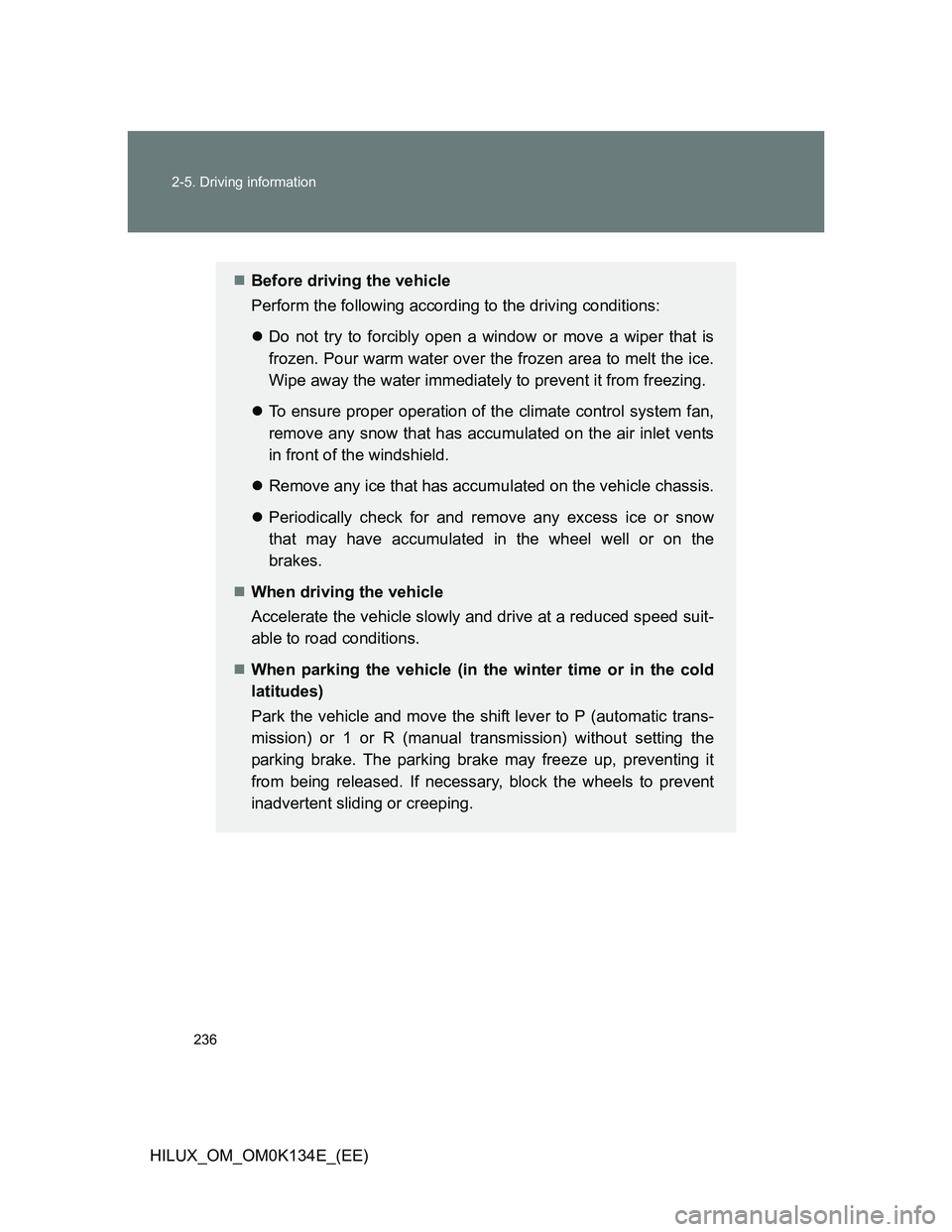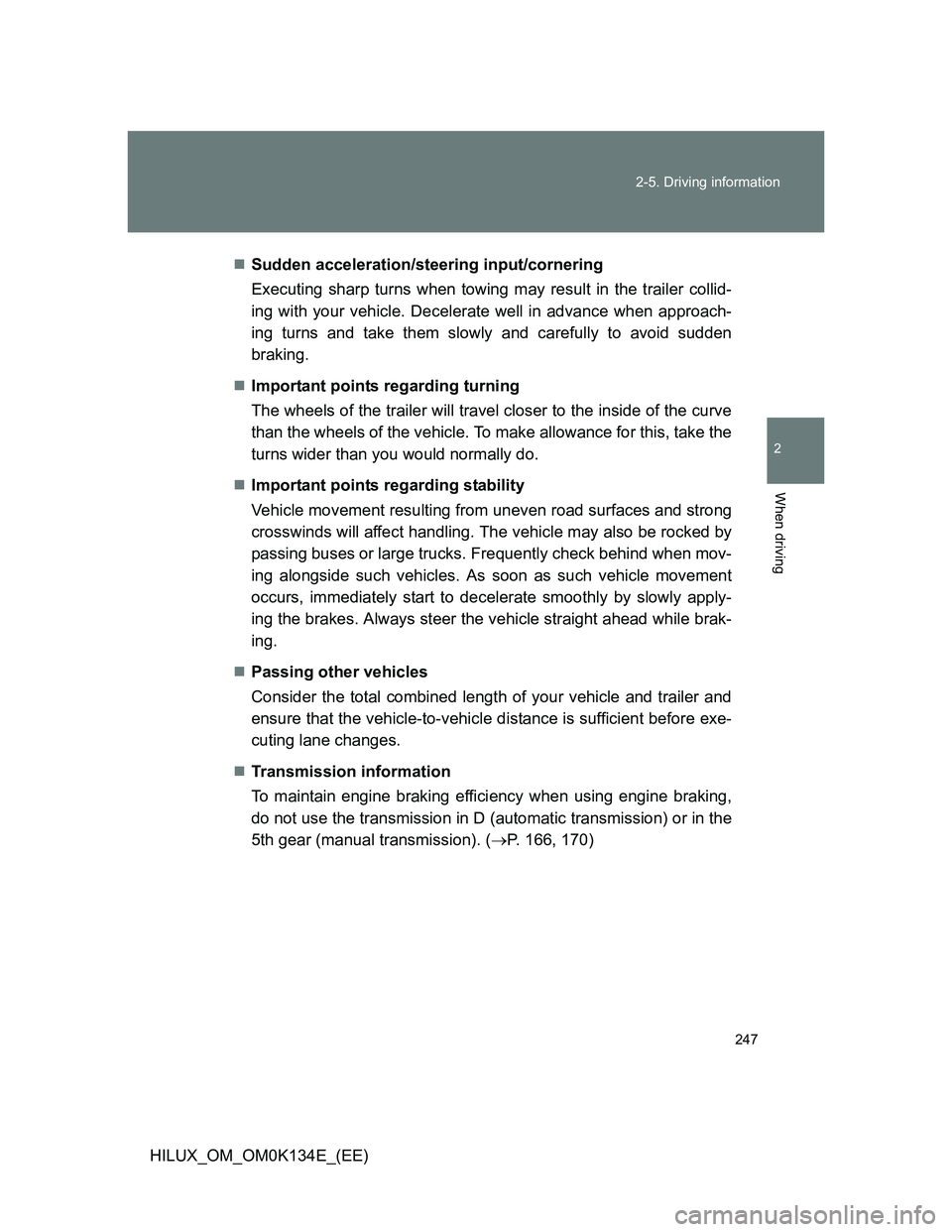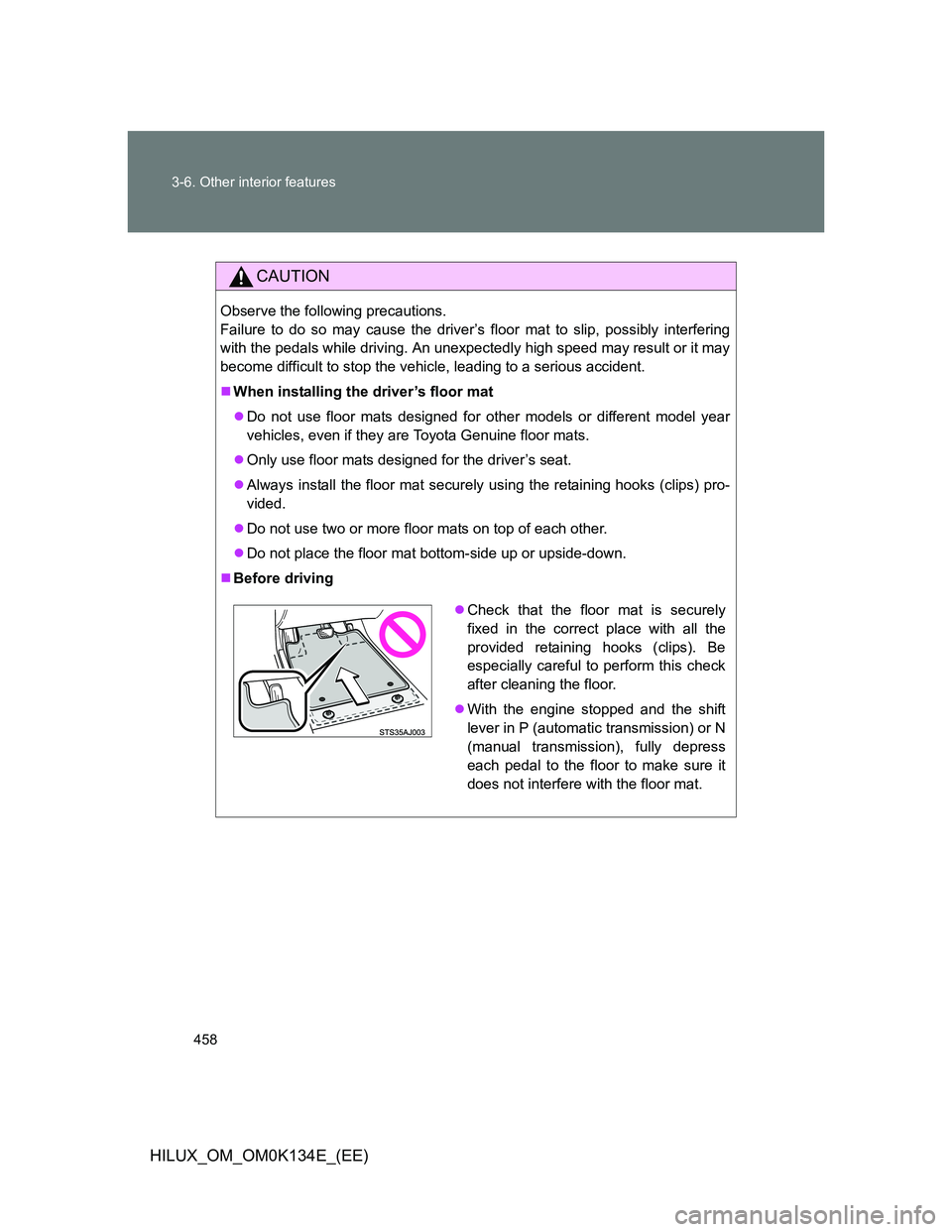Page 229 of 644

229 2-4. Using other driving systems
2
When driving
HILUX_OM_OM0K134E_(EE)
Regeneration with the DPF system switch (if equipped)
After pressing the DPF system switch, do not depress the accelerator
pedal or the clutch pedal (manual transmission). Depressing the pedal(s)
will stop regeneration. If regeneration has been stopped, restart regener-
ation as soon as possible.
If regeneration is carried out while the exhaust pipe is hot (for example
directly after driving), it will take less time than when the engine is cold.
Replacing the engine oil
Make sure to use an oil of the recommended grade or of matching quality.
(P. 610)
DPF system warning
Under the following driving conditions, the DPF system warning light may
come on earlier than normal.
*
When only driving at low speeds (for example 20 km/h [12 mph] or
below).
If the engine is turned on and off frequently (if the engine is not left run-
ning for more than 10 minutes at a time).
*: Differs in accordance with weather, driving conditions, etc.
Page 236 of 644

236 2-5. Driving information
HILUX_OM_OM0K134E_(EE)
Before driving the vehicle
Perform the following according to the driving conditions:
Do not try to forcibly open a window or move a wiper that is
frozen. Pour warm water over the frozen area to melt the ice.
Wipe away the water immediately to prevent it from freezing.
To ensure proper operation of the climate control system fan,
remove any snow that has accumulated on the air inlet vents
in front of the windshield.
Remove any ice that has accumulated on the vehicle chassis.
Periodically check for and remove any excess ice or snow
that may have accumulated in the wheel well or on the
brakes.
When driving the vehicle
Accelerate the vehicle slowly and drive at a reduced speed suit-
able to road conditions.
When parking the vehicle (in the winter time or in the cold
latitudes)
Park the vehicle and move the shift lever to P (automatic trans-
mission) or 1 or R (manual transmission) without setting the
parking brake. The parking brake may freeze up, preventing it
from being released. If necessary, block the wheels to prevent
inadvertent sliding or creeping.
Page 247 of 644

247 2-5. Driving information
2
When driving
HILUX_OM_OM0K134E_(EE)Sudden acceleration/steering input/cornering
Executing sharp turns when towing may result in the trailer collid-
ing with your vehicle. Decelerate well in advance when approach-
ing turns and take them slowly and carefully to avoid sudden
braking.
Important points regarding turning
The wheels of the trailer will travel closer to the inside of the curve
than the wheels of the vehicle. To make allowance for this, take the
turns wider than you would normally do.
Important points regarding stability
Vehicle movement resulting from uneven road surfaces and strong
crosswinds will affect handling. The vehicle may also be rocked by
passing buses or large trucks. Frequently check behind when mov-
ing alongside such vehicles. As soon as such vehicle movement
occurs, immediately start to decelerate smoothly by slowly apply-
ing the brakes. Always steer the vehicle straight ahead while brak-
ing.
Passing other vehicles
Consider the total combined length of your vehicle and trailer and
ensure that the vehicle-to-vehicle distance is sufficient before exe-
cuting lane changes.
Transmission information
To maintain engine braking efficiency when using engine braking,
do not use the transmission in D (automatic transmission) or in the
5th gear (manual transmission). (P. 166, 170)
Page 248 of 644

248 2-5. Driving information
HILUX_OM_OM0K134E_(EE)If the engine overheats
Towing a loaded trailer up a long, steep incline in temperatures
exceeding 30C (85F) may result in the engine overheating. If the
engine coolant temperature gauge indicates that the engine is
overheating, turn the air conditioning off immediately, leave the
road and stop the vehicle in a safe place. (P. 592)
When parking the vehicle
Always place wheel chocks under the wheels of both the vehicle
and trailer. Firmly set the parking brake and shift the shift lever to P
for automatic transmissions, and 1 or R for manual transmissions.
CAUTION
Follow all the precautions described in this section. Failure to do so could
cause an accident resulting in death or serious injury.
Trailer towing precautions
When towing, make sure that none of the weight limits are exceeded.
(P. 240)
Vehicle speed in towing
Observe the legal maximum speeds for trailer towing.
Before descending hills or long declines
Reduce speed and downshift. However, never downshift suddenly while
descending steep or long down hill grades.
Operation of the brake pedal
Do not hold the brake pedal depressed often or for long periods of time.
Doing so may result in the brake overheating or reduce braking effects.
Page 458 of 644

458 3-6. Other interior features
HILUX_OM_OM0K134E_(EE)
CAUTION
Observe the following precautions.
Failure to do so may cause the driver’s floor mat to slip, possibly interfering
with the pedals while driving. An unexpectedly high speed may result or it may
become difficult to stop the vehicle, leading to a serious accident.
When installing the driver’s floor mat
Do not use floor mats designed for other models or different model year
vehicles, even if they are Toyota Genuine floor mats.
Only use floor mats designed for the driver’s seat.
Always install the floor mat securely using the retaining hooks (clips) pro-
vided.
Do not use two or more floor mats on top of each other.
Do not place the floor mat bottom-side up or upside-down.
Before driving
Check that the floor mat is securely
fixed in the correct place with all the
provided retaining hooks (clips). Be
especially careful to perform this check
after cleaning the floor.
With the engine stopped and the shift
lever in P (automatic transmission) or N
(manual transmission), fully depress
each pedal to the floor to make sure it
does not interfere with the floor mat.
Page 549 of 644
5
549
5-1. Essential information
When trouble arises
HILUX_OM_OM0K134E_(EE)
If your vehicle needs to be towed
Before towing
The following may indicate a problem with your transmission. Contact
any authorized Toyota dealer or repairer, or another duly qualified
and equipped professional, before towing.
The engine is running but the vehicle will not move.
The vehicle makes an abnormal sound.
If towing is necessary, we recommend having your vehicle towed by
any authorized Toyota dealer or repairer, or another duly qualified
and equipped professional, such as or a commercial towing service,
using a lift-type truck or flatbed truck.
Use a safety chain system for all towing, and abide by all state/pro-
vincial and local laws.
Page 554 of 644

554 5-1. Essential information
HILUX_OM_OM0K134E_(EE)
NOTICE
To prevent causing serious damage to the transmission and transfer
(4WD models) when towing using a wheel-lift type truck (vehicles with
automatic transmission)
Pre Runner: Never tow this vehicle from the front with the rear wheels on the
ground.
4WD models: Never tow this vehicle with any of the wheels in contact with
the ground.
To prevent damage to the vehicle when towing using a wheel-lift type
truck (vehicles with manual transmission)
Do not tow the vehicle from the rear when the engine switch is in the
“LOCK” position or the key is removed. The steering lock mechanism is
not strong enough to hold the front wheels straight.
When raising the vehicle, ensure adequate ground clearance for towing at
the opposite end of the raised vehicle. Without adequate clearance, the
vehicle could be damaged while being towed.
To prevent body damage when towing with a sling-type truck
Do not tow with a sling-type truck, either from the front or rear.
Page 559 of 644
5
559 5-2. Steps to take in an emergency
When trouble arises
HILUX_OM_OM0K134E_(EE)
Warning lightWarning light/Details
SRS warning light
Indicates a malfunction in:
• The SRS airbag system; or
• The seat belt pretensioner system
ABS warning light
Indicates a malfunction in:
• The ABS; or
• The brake assist system (vehicles with VSC system)
(flashes)
and
VSC OFF and slip indicator lights (if equipped)
Indicates a malfunction in:
• Vehicle stability control; or
• Traction control
(flashes)
Four-wheel drive indicator light
Indicates a malfunction in the four-wheel drive system
(P. 212)
Cruise control indicator light*3 (if equipped)
Indicates a malfunction in the cruise control system
(P. 202)
Automatic transmission fluid temperature warning
light (if equipped)
Indicates that the automatic transmission fluid tempera-
ture is too high.
Timing belt replacement warning light
Indicates that the timing belt should be replaced